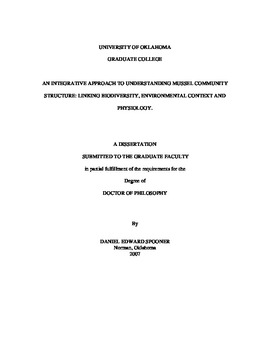| dc.contributor.advisor | Vaughn, Caryn, | en_US |
| dc.contributor.author | Spooner, Daniel Edward. | en_US |
| dc.date.accessioned | 2013-08-16T12:20:53Z | |
| dc.date.available | 2013-08-16T12:20:53Z | |
| dc.date.issued | 2007 | en_US |
| dc.identifier.uri | https://hdl.handle.net/11244/1249 | |
| dc.description.abstract | The focus of my third chapter is an integration of the physiology information collected in chapter two to address how species dominance of two distinct thermal guilds (thermally-tolerant and thermally-sensitive) influences gross primary production. I manipulated temperature (15, 25, and 35° C) and species dominance of five mussel species (A. ligamentina, A. plicata and Q. pustulosa, M. nervosa, and O. reflexa) using 1101 re-circulating stream mesocosms housed in an environmentally-controlled room. I quantified individual-based measures of resource acquisition (oxygen consumption, body condition index) and ecosystem services (ammonia and phosphorus excretion rates) for each species. In addition, I quantified gross primary production in the water column, benthos, and the entire stream mesocosm. Gross primary production was highest at 35° C and was positively related to both A. ligamentina and A. plicata dominance with communities. However, species dominance differentially influenced gross primary production of different compartments within the mesocosms with A. plicata (a thermally-tolerant species) positively influencing benthic production, and A. ligamentina (a thermally-sensitive species) positively influencing water column production. Species interactions within treatments were context dependent with A. ligamentina positively influencing A. plicata, M. nervosa, and O. reflexa at 25° C and negatively influencing M. nervosa and O. reflexa at 35° C. In addition to influencing resource acquisition, species dominance also influenced species-specific nutrient excretion rates and subsequently water-column nutrient levels. | en_US |
| dc.description.abstract | The research detailed in my second chapter built upon observed patterns of alternating species dominance by asking if different mussel species performed differently under a variety of thermal regimes. To address this question, I acclimated eight mussel species (Lampsilis cardium, Fusconaia flava, Actinonaias ligamentina, Megalonaias nervosa, Amblema plicata, Quadrula pustulosa, Obliquaria reflexa, and Truncilla truncata) to four temperatures (5, 15, 25, and 35° C). I quantified resource acquisition (clearance rate and oxygen consumption), assimilation (glycogen, body condition index, and Q10 rates of anabolism and catabolism), and ecosystem services (ammonia and phosphorus excretion rates, and biodeposition rates) using temperature-controlled respirometers. The results of this experiment demonstrate that although mussels are generally categorized as "filter feeders", there are distinct guilds within this functional group associated with their response to temperature. Megalonaias nervosa, Amblema plicata, Obliquaria reflexa, and Fusconaia flava are thermally-tolerant species assimilating energy at 35° C and increasing the magnitude of services (nutrient excretion, clearance and biodeposition rates) they contribute to ecosystems. Alternatively, A. ligamentina, L. cardium, Q. pustulosa , and Truncilla truncata appear to be thermally-sensitive with increased rates of catabolism at 35° C. However, the functional responses of thermally-sensitive species appeared to differ with some species decreasing filtration activity and increasing rates of nutrient excretion and others increasing both filtration and nutrient excretion rates. Extrapolating these data to real mussel communities highlighted the importance of the relative dominance between thermally-sensitive and tolerant-species under differing environmental contexts. Furthermore, shifts in community structure would be predicted to influence the nature of filtration, biodeposition and nutrient dynamics under current models of climate change. | en_US |
| dc.description.abstract | My first chapter integrated biodiversity partitioning techniques with mussel community data across twenty one mussel beds to determine if mussel community biomass could be explained by patterns of species richness or species dominance. This partitioning approach tested the null hypothesis that biomass accrual within mussel beds is equal at all sites. The results of this work demonstrated that mussel biomass is largely explained by complementarity, which indicates that either niche partitioning or facilitation between mussel species is occurring. This conclusion was further supported by the fact that complementarity was highest in species rich, thermally variable mussel beds. In addition, numerically rarer species were in better condition (reduced oxygen consumption rates and higher body condition indices) in species-rich, thermally variable mussel beds which suggests that there is an energetic benefit to living in species rich communities. | en_US |
| dc.description.abstract | The research detailed in my dissertation broadens our understanding of the biodiversity-ecosystem function paradigm using long-lived invertebrates in a freshwater ecosystem. Freshwater mussels (Unionoidea) are a globally threatened fauna with 70% of taxa considered threatened, yet little is known concerning their functional role. In addition to species extinctions, the overall biomass of both abundant and rare unionid species is declining in most rivers, and this loss of filter-feeding biomass is predicted to impact river function. | en_US |
| dc.format.extent | xiv, 113 leaves : | en_US |
| dc.subject | Biology, Ecology. | en_US |
| dc.subject | Freshwater mussels Physiology. | en_US |
| dc.subject | Biotic communities. | en_US |
| dc.subject | Freshwater mussels Ouachita Mountains (Ark. and Okla.) | en_US |
| dc.title | An integrative approach to understanding mussel community structure: Linking biodiversity, environmental context and physiology. | en_US |
| dc.type | Thesis | en_US |
| dc.thesis.degree | Ph.D. | en_US |
| dc.thesis.degreeDiscipline | Department of Biology | en_US |
| dc.note | Source: Dissertation Abstracts International, Volume: 68-07, Section: B, page: 4239. | en_US |
| dc.note | Adviser: Caryn Vaughn. | en_US |
| ou.identifier | (UMI)AAI3273885 | en_US |
| ou.group | College of Arts and Sciences::Department of Biology | |
